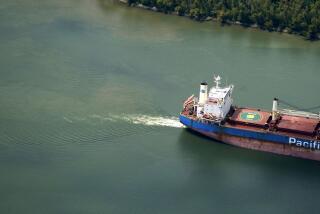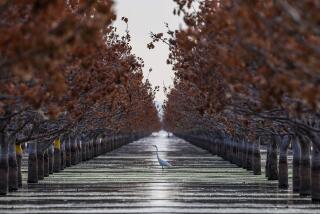A Lake Shrinks From Drought and Disarray
- Share via
OKEECHOBEE, Fla. — This state is in the grip of what may be its worst drought in recorded history. How dry is it? Parts of Lake Okeechobee, in normal years a vast reservoir for slaking the thirst of farms, industry and people, can now be set on fire.
At Pahokee, a farm town of 9,500 on the southeast shore of Lake Okeechobee, sailboats and motorboats lie on the sand or muck of the now exposed lake bed. The town, which draws its drinking water from the lake, had to lower the intake nozzle to avoid sucking in air and may not have dropped it enough.
“This is the worst drought in 100 years,” said Randy Smith, spokesman for the South Florida Water Management District, based in West Palm Beach. “Every eight to 10 years in Florida, a spell of drought, like clockwork, comes in. But I’ve never seen it this bad.”
An uncommonly long dry spell is certainly to blame. According to Ken Svoboda, a climate expert at the National Drought Mitigation Center at the University of Nebraska-Lincoln, Miami this year has received only 74% of its customary rainfall, Orlando and Jacksonville 61%.
Lake Okeechobee, the nation’s largest body of fresh water after the Great Lakes, has dropped to record lows. This week, the mean water level fell under 10 feet above sea level, more than 5 feet below where it was at this time last year.
However, there is little doubt nature has been assisted by man, a familiar enough story in a state where growth and development, like sorcerers’ apprentices, often usher in unforeseen consequences.
Last year, the water management district intentionally drained more than 100 billion gallons from Lake Okeechobee, which in normal times holds enough to meet four years of potable water demand for Miami, Fort Lauderdale, West Palm Beach and the other cities on the southern Atlantic Coast.
Officials acted after five years of human-engineered high-water levels in the lake had been blamed for killing aquatic vegetation and ruining the habitat of a species of fish greatly popular with anglers, the large-mouth bass.
In pulling the plug at Okeechobee in April 2000, “the [water management] board took a chance,” said Tommy Strowd, the district’s director of operations.
With the rainfall drying up, the timing turned out to be lousy.
Okeechobee is the ultimate backup source for a complex water system that also includes subterranean aquifers and above-ground holding pools on the fringes of populated Southeast Florida. The lake is considered the “liquid heart” of the system.
So far, according to Strowd, the overall water situation in South Florida is serious but not critical. Rationing has not yet affected agriculture or industry.
Millions of homeowners in Florida’s center and south are under orders to water their lawns no more than twice a week or face fines. Restaurants on the lower Atlantic and Gulf coasts are supposed to give customers a glass of water on request only.
Moving to a more stringent level of rationing would cost the state at least $650 million, water officials say, with victims as varied as citrus groves, the landscape industry, golf courses and tourism.
“If the lake keeps going down, it could get hairy,” Pahokee City Manager Ken Schenck said.
The underground aquifers that provide water for the cities are near their normal levels, Strowd said. But if the lack of rain continues, water may have to be siphoned from Okeechobee to replenish those subterranean reservoirs.
“We may not see the lake recover to levels sufficient to get us through the next dry season,” Strowd said. “In that case, we’re looking at the very real possibility of a multiyear drought.”
Water managers in South Florida have the difficult, perhaps impossible chore of satisfying myriad public sectors, such as sugar cane growers, cattle ranchers and beachfront communities, whose needs often conflict.
Carroll Head, 63, a bass fisherman and president of the Friends of Lake Okeechobee, an activist group, believes officials maintained the lake at dangerously high levels in part to make sure there would be water to keep South Florida’s golf courses lushly green.
“We may be in a losing fight here. I admit it,” Head said. “There are a lot more golfers than bass fishermen.”
Nowhere are the effects of the drought more obvious than on Okeechobee and the namesake town of 48,000 on its north shore. The lake, which normally sprawls to drown the equivalent of 500,000 football fields, is shrinking.
A mile from the earthen dam that rings the lake, the water may be only 2 feet deep, a third of its customary depth. Near the mouth of the Kissimmee River, the shoreline has receded by 150 feet and more. Bullrushes are normally drenched in water but now tremble naked in the breeze as buzzards stalk on sand bars left by the vanishing waters.
Taking advantage of the receding waterline, officials last year began setting fires in the dry lake bed to destroy 20,000 acres of torpedo grass and other invading plants not native to Florida. Wildfires set by arsonists, most recently this March, have consumed an additional 53,000 acres.
“The little town’s going to suffer this summer. I mean, suffer bad,” said Harvey Ford, 68, who last week canceled two bass fishing tournaments due to the low water level. “There’s going to be some businesses fold. Little mom-and-pop places. They can’t take it.”
Greg and Karen MacLean, who bought a fishing tackle shop in November, say the demand for fishing guides is way off. “The next two months are normally busy and booked way in advance, but we’ve got 50% open dates,” Greg MacLean said.
Karen MacLean apologizes in advance, but says she prays for a hurricane later this year to bring plenty of rain.
Wildlife has also been affected. Airboat captains on Lake Okeechobee report seeing young dead alligators that starved because marshes where they normally lie in ambush for wading birds are now high and dry. In Highlands County, northwest of the lake, one resident said a 12-foot bull gator, thirsty and famished, recently ate his neighbor’s cat, then clamped his jaws around the bumper of a truck.
In large part to stop the environmental havoc caused by stockpiling water in the lake, Florida officials have come up with a controversial plan to store billions of gallons of untreated rainwater in the ground instead.
David Struhs, secretary of the state’s Department of Environmental Protection, says the plan is to pump the water 800 feet down into a layer of limestone. It could then be retrieved, treated to existing federal drinking-water standards and used to keep Everglades National Park and the other marshlands south of Lake Okeechobee wet.
This water wouldn’t be used for supplying municipalities, Struhs said in an interview, but would indirectly help by keeping the pressure up in underwater aquifers. That would keep seawater from intruding and polluting the water sources of coastal towns.
The Environmental Protection Agency, which normally requires that water pumped into the ground be treated beforehand, hasn’t given formal approval to Florida’s plan.
Some critics call the proposal, which preceded the drought, a threat to health and the environment. Struhs says there is no risk for humans--and that it’s much better for Lake Okeechobee.
“We’re trying to restore the lake and use it less over time like a reservoir and more like a lake,” Struhs said.
(BEGIN TEXT OF INFOBOX / INFOGRAPHIC)
Drought’s Scope
Lake Okeechobee is the heart of South Florida’s water supply. One official calls the current drought the worst in 100 years.
Source: NOAA
More to Read
Sign up for Essential California
The most important California stories and recommendations in your inbox every morning.
You may occasionally receive promotional content from the Los Angeles Times.










